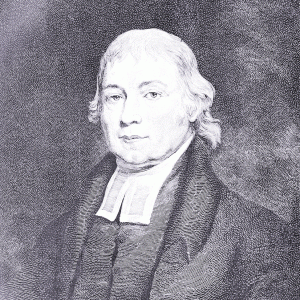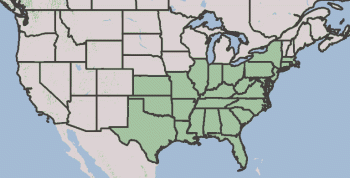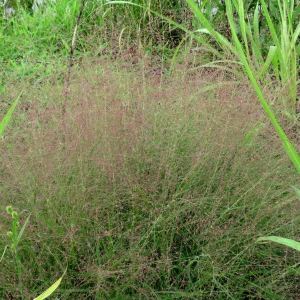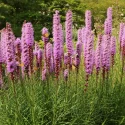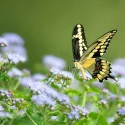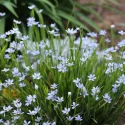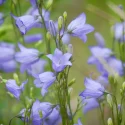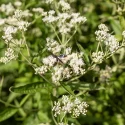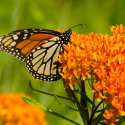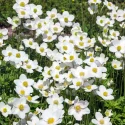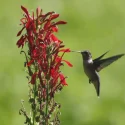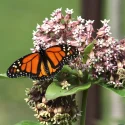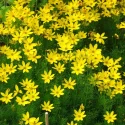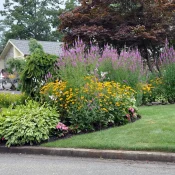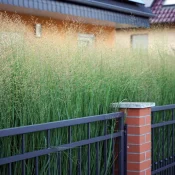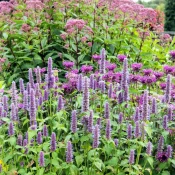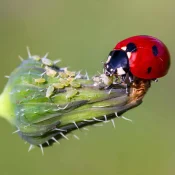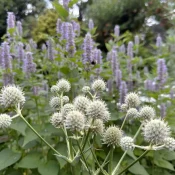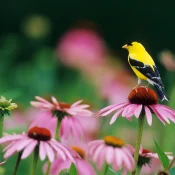Purple Muhly Grass
Yes—this is a real, native plant—not one manufactured by Photoshop. Purple Muhly Grass is thin, green, and elegant in the spring and summer, and followed by frothy pink-purple tufts in the fall. Purple Muhly Grass is stunning when planted in clumps. Pair it with native flowers like Rattlesnake Master, Golden Alexander, coneflowers, and asters, and don’t forget to add a nametag—your neighbors will want some, too. Scroll on to find planting tips.
- Full Sun, Part Sun
- Medium (3-5')
- Fall flowers
- Amazing fall color

Purple Muhly Grass is a stunning, easy-to-care-for native grass that puts on a purple-tipped show from August to October. It is native to a huge section of North America and is drought-tolerant and salt-tolerant (which means it can withstand being planted near roads). It’s also evergreen in many areas. In this article, we’ll discuss its benefits, share landscaping tips, and give ideas on where to find some for your garden.
The world is filled with grasses. So let’s start with a basic question about what makes this one special:
What are the benefits of planting Purple Muhly Grass?
Purple Muhly Grass is a plant native to North America. Native plants have grown in an area for hundreds, thousands, and millions of years. Built within Purple Muhly Grass is the DNA to thrive in its home area’s soil, climate, and weather better than non-native plants.
Here are three reasons why planting native plants like Purple Muhly Grass is worth it:
- Drought-friendly gardening. Like many North American native grasses, Purple Muhly’s roots go down deep, helping store water for dry periods.
- Save time and money: after the first year of getting established, native plants are happy with rain.
- Native plants are gorgeous! Purple Muhly Grass is a perfect example of how beautiful and resilient native plants are—they are always the best choice for our gardens.
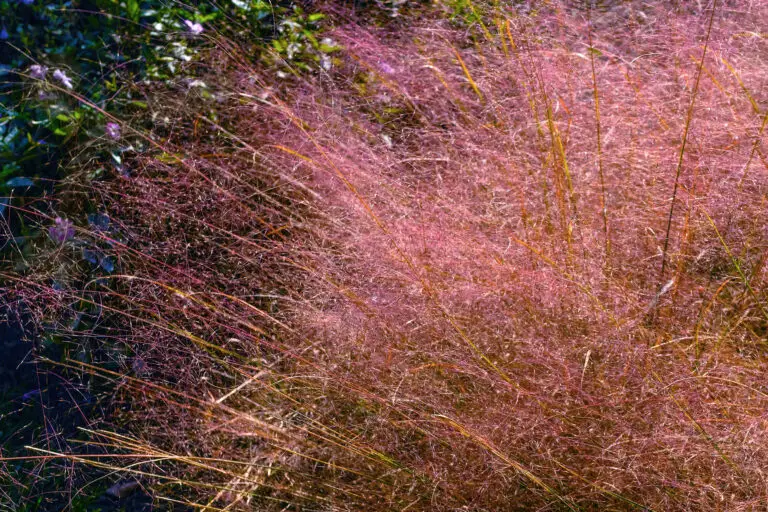
We can see quickly how stunning this plant is. Before we head into its native range, let’s answer another burning question:
Why is it called Muhly grass?
According to the North Carolina Extension Gardener Toolbox, the name comes from an early American botanist who lived in Pennsylvania during the Revolutionary War. “The genus, Muhlenbergia, was named after Gotthilf Muhlenberg, a botanist, chemist, and mineralogist. He is credited with classifying and naming at least 150 species of plants in his Index Flora Lancastriensis, published in 1785. He lived from 1753-1815. The specific epithet, capillaris, means fine or hair-like.”
Muhly grass is just one of thousands of plants and animals’ Latin names inspired by humans. Recently, this practice has been questioned. An international team of researchers argued in 2023, “The Earth’s biodiversity is part of a global heritage that should not be trivialized by association with any single human individual, whatever their perceived worth.” Smithsonian magazine has a good overview if you’d like to learn more.
If you’d like to laugh at some other native plant names…
Truthfully, exploring the strange backstories of plant names is one of our favorite research tasks at The Plant Native. To read what we’ve found, visit our article on Terrible Names, Beautiful Native Plants. Some examples of strangeness include Boneset, Tickseed, and Joe Pye Weed.
Now that we know a little about Purple Muhly Grasses’ name, you are probably wondering:
Where is Purple Muhly Grass native?
Purple Muhly Grass is native to almost half of the United States, from New York south to Florida and west to Texas.
Does Purple Muhly Grass come back year after year?
Yes! Because Purple Muhly Grass is a perennial, plant once and it will come back year after year.
How to plant (and where to plant) Purple Muhly Grass
Maybe you think from the sight of this plant that it will be fussy to take care of. But Purple Muhly Grass thrives in neglect. Take it from the LSU Agricultural Center:
“Muhly grass makes a good selection in the landscape because it requires little to no maintenance. You may want to remove the dead vegetation from time to time. However, it is recommended to leave the biomass in the fall and over winter to provide a habitat for insects and small animals. Cutting back or grooming of the plant is best done in the spring, when you can cut the clump completely back to the ground, allowing new growth to replace it.”
From personal experience, I bought some at the Penn State Extension Master Gardener plant sale three years ago. I watered it the first year to establish it, and I have done nothing besides applying some mulch and cutting it back in the spring. Its care takes me about 10 minutes a year.
Left entirely to its own devices and watered with just rain, it has thrived and has doubled in size. I dug some up and gave some to my neighbor when it started crowding plants around it. And now you’re wondering…
How big does Purple Muhly Grass get?
Purple Muhly Grass gets three feet wide and three feet tall. It takes around three years to reach this size.
If it gets too big, dig it up and divide it. Here’s how:
- Dig up the plant in the spring, digging down at least one foot to try and get as much of the roots as possible
- Divide it in half with a garden knife or a shovel
- Give away or replant the pieces
- Water during the first year to get established
- Enjoy more years of fuss-free beauty
Most native perennial flowers double in size every three years. When most native perennials get too big, you can dig up, divide it, and double your plants. It’s another reason why planting native is fun—free plants!
Does this plant seem too big for your space?
Then, let us introduce you to another native, purple-hued grass that’s shorter with a stellar name: Purple Lovegrass. Their similarities are easy to spot:
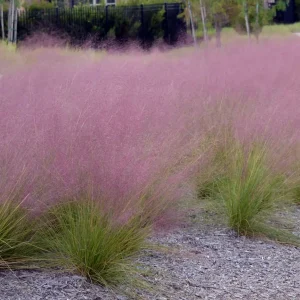
Purple Muhly Grass
- Height: 2-4 feet tall
- More clumped grass
- Cinematic beauty: Green in spring, color in late summer into fall, bronze after
- Drought-tolerant
- Salt-tolerant: Ok to plant near roads
Purple Lovegrass
- Short: 1-2 feet tall
- More airy, open grass
- Cinematic beauty: Green in spring, color in late summer into fall, bronze after
- Drought-tolerant
- Salt-tolerant: Ok to plant near roads
What does Purple Muhly Grass look like when it’s not blooming?
Purple Muhly Grass has green, thin blades of grass year-round. Here’s how it looks throughout the seasons:
- Spring: New shoots of blue-green grass grow. Use it like a green backdrop with spring-flowering natives nearby.
- Summer: The grass grows taller—2-3 feet—and stays green.
- Fall: Enjoy their pink-purple seed clouds alongside green stems.
- In late fall and winter: Purple clouds turn to light bronze. You’ll see songbirds visiting to get a snack.
- Early Spring: Cut the plant back to 6″ high to encourage new growth and start fresh for the season.
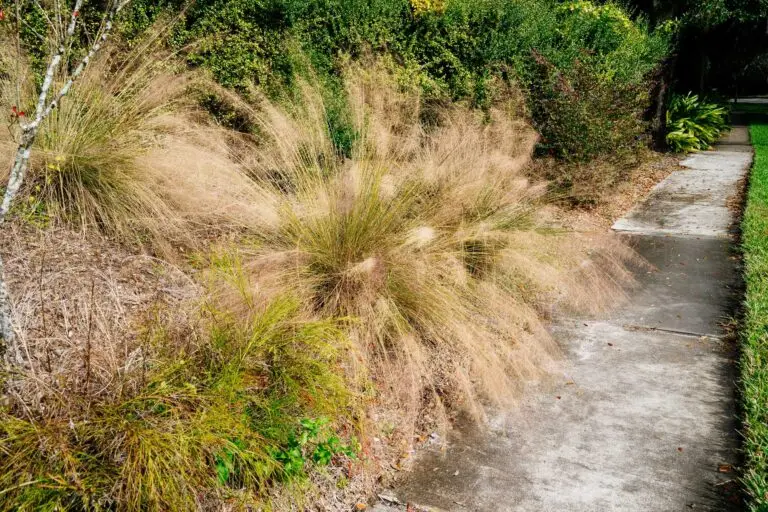
What are good places to plant Purple Muhly Grass?
Purple Muhly Grass thrives in lots of landscapes, thanks to its careful nature. Here are some tips for picking a planting spot.
Make sure there is good drainage
Purple Muhly Grass is very resilient. It is drought-tolerant and can happily grow in clay or rocky soils. The only thing it does not like is being waterlogged, so ensure it’s planted in an area with good drainage.
Purple Muhly Grass looks amazing in a group planting
Because it looks so good planted in a group, we’ve included it in our round-up of Single-Plant Gardens, which are landscaping ideas driven by a single plant (aka one-stop landscaping.)
Good spots for planting Purple Muhly Grass include:
- Pollinator gardens
- Borders
- Parking lots
- Foundation plantings
- Along driveways
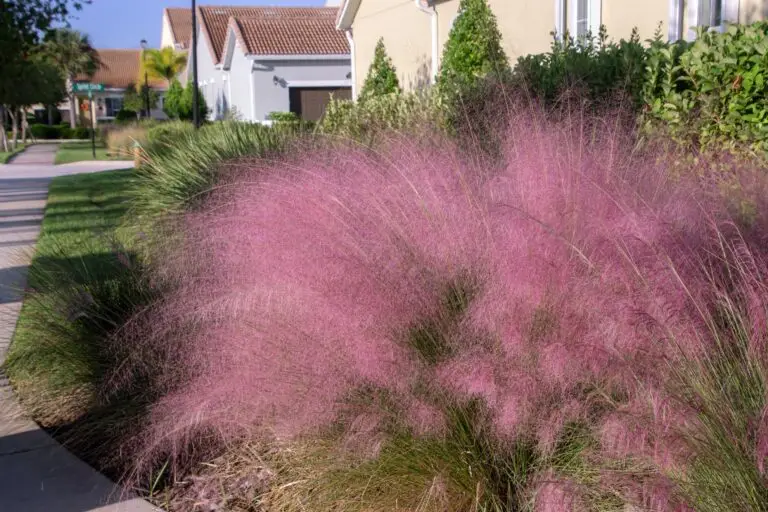
Planting Muhly Grass by seed or plants
We’re not going to lie: sometimes finding specific native plants can be a challenge. Big box stores carry more non-native options than native options.
Planting Purple Muhly Grass is seed-friendly
According to LSU Agricultural Center, “Purple muhly can be established very quickly, in as little as one to two weeks from seed.”
We have four tips to find either seeds or plants for Purple Muhly Grass:
Where can I find seeds and plants?
Finding native plants can be challenging (we partly blame Marie Antoinette.) To make it easier, we’ve assembled four sourcing ideas.
Native Nursery List
300+ native nurseries makes finding one a breeze
Online Native Plant Sellers
We've included 100+ online resources to help
Society Plant Sales
Every state has a native plant society; find yours
Online Communities
Local Facebook groups are a great plant source
What are good pairings for Purple Muhly Grass?
Pair Purple Muhly Grass with plants that match the light it’s planted in. Full sun pairings include coneflower, Rattlesnake Master, milkweed, goldenrod, and Bee Balm. Part sun pairings include Golden Alexander, False Blue Indigo, asters, and Alumroot.
Full sun pairings
Part sun pairings
And that sums up our beginner’s guide to Purple Muhly Grass! Purple Muhly Grass is a super easy-to-grow native grass that looks stop-you-in-your-tracks stunning when it’s in bloom in the late summer and fall. It looks best planted in large groups so you can enjoy its frothy pink-purple clouds. Because it is a perennial, plant it once, and it will return year after year. Make sure you make a nametag—people will want to know how they can get some, too. Don’t forget to meet its better-named cousin, Purple Lovegrass, to build a candy-colored garden. Or visit our regional guides for Northeast, Midwest, Mid-Atlantic, or Southern gardens to explore other options. Happy planting!
Sources
- Nelson, Gil. Best Native Plants for Southern Gardens: A Handbook for Gardeners, Homeowners, and Professionals, (2010), 346.
- Harstad, Carolyn. Go Native! Gardening with Native Plants and Wildflowers in the Lower Midwest. (1999), 209-210.
- Hoffman Nursery, Pink Muhly Grass
- North Carolina Extension, Muhlenbergia capillaris
- Mears, James A. “Some Sources of the Herbarium of Henry Muhlenberg (1753-1815).” Proceedings of the American Philosophical Society, vol. 122, no. 3, 1978, pp. 155–74. JSTOR, http://www.jstor.org/stable/986550.
- Muhlenberg, Henry. “Index Florae Lancastriensis, Auctore Henrico Muhlenberg, D. D.” Transactions of the American Philosophical Society 3 (1793): 157–84. https://doi.org/10.2307/1004866.
- Blanchard, Jennifer and DoBoer, Eric. Native Grasses for the Landscape: Purple Muhly, Louisiana State University Agricultural Center. (PDF.)
- Kirk, S. and Belt, S. 2010. Plant Fact Sheet for Hairawn Muhly (Muhlenbergia capillaries), USDA-Natural Resources Conservation Service. (PDF.)
